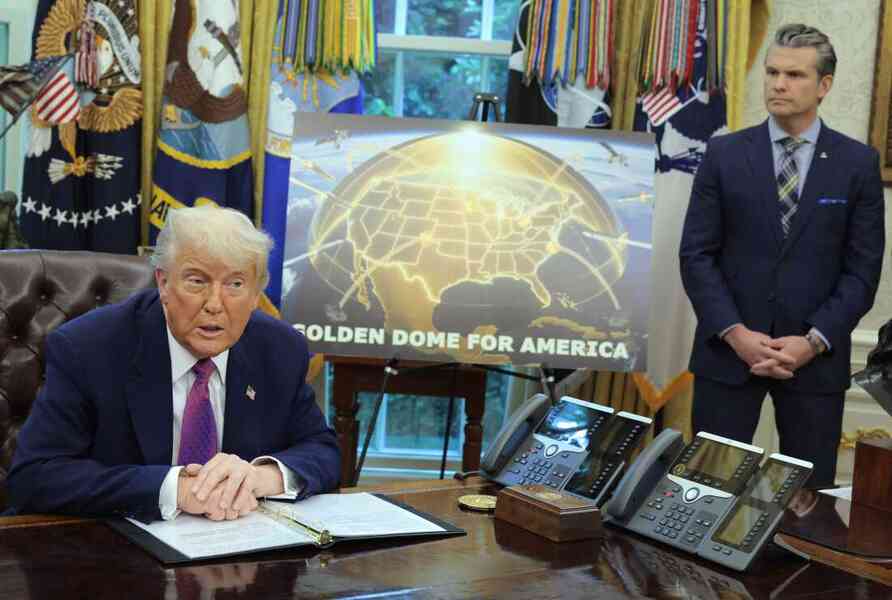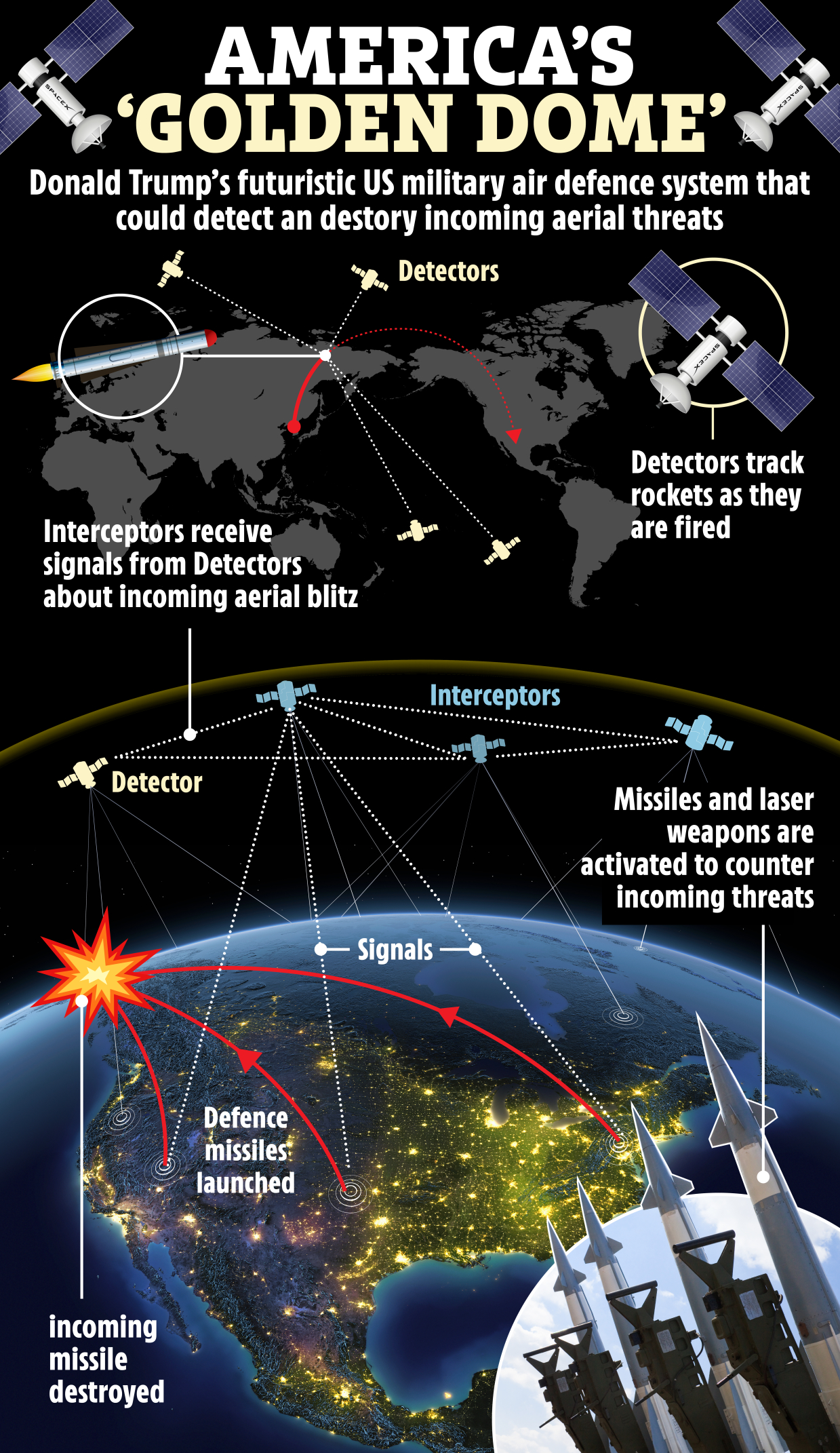Trump’s Golden Dome Unveils Global Security Enigma
A bold missile defense plan sparks hope and fear—what’s the real cost?

A Shockwave from the Oval Office
On May 21, 2025, President Donald Trump stood in the Oval Office, flanked by Defense Secretary Pete Hegseth and Space Force General Michael Guetlein, unveiling the “Golden Dome” missile defense system. The announcement, made against a backdrop of posters depicting a golden-shielded U.S., sent ripples through global politics. Described as a $175 billion shield to counter ballistic, hypersonic, and cruise missiles, the plan promises to protect America from threats launched “even from space.” But with costs potentially soaring to $542 billion over 20 years, according to the Congressional Budget Office, is this a game-changer or a fiscal vortex?
The timing couldn’t be more charged. Tensions with China and Russia escalate as both nations develop advanced missile technologies that outpace current U.S. defenses. Just last month, on April 24, 2025, a Russian missile strike lit up Kyiv’s skies, a stark reminder of modern warfare’s stakes. Trump’s plan, inspired by Israel’s Iron Dome, aims to create a multi-layered defense—ground, sea, and space-based—capable of intercepting missiles at all four stages: pre-launch, boost, midcourse, and terminal.
The Plan: Satellites, Lasers, and Ambition
The Golden Dome envisions a network of hundreds of satellites equipped with sensors and interceptors to neutralize threats from nations like China, Iran, North Korea, or Russia. Space-based lasers, likened to “Hubble telescopes” in scale, would detect and destroy missiles before they reach U.S. soil. Trump claims the system could be operational by 2029, though experts, including Pentagon officials, caution that full interception capabilities may take longer due to technological hurdles.
General Michael Guetlein, tasked with overseeing the project, emphasized integration with existing defenses like THAAD and Aegis systems. Companies like SpaceX, Palantir, and Anduril are frontrunners to build key components, with SpaceX proposing a subscription-based model for government access. This has sparked concerns, with 42 members of Congress, led by Sen. Elizabeth Warren and Rep. Greg Casar, demanding an investigation into potential conflicts of interest involving Elon Musk’s SpaceX.

Global Reactions: Allies and Adversaries Speak
China’s response was swift and sharp. On May 21, 2025, Foreign Minister Mao Ning called the Golden Dome a “strong offensive” move, warning it risks “turning space into a warzone.” Beijing argues the plan violates the Outer Space Treaty and could trigger a global arms race. Russia echoed this, with the Kremlin suggesting it may push for new strategic arms talks. Both nations, in a joint statement earlier this month, labeled the project “deeply destabilizing.”
Meanwhile, Canada is exploring participation. Prime Minister Mark Carney’s office confirmed “active discussions” to integrate the Golden Dome with NORAD, though details on funding or roles remain unclear. This comes amid strained U.S.-Canada relations, with Trump recently threatening tariffs and joking about Canada becoming a U.S. state.
Israel, whose Iron Dome inspired Trump’s vision, offers a model. Since 2011, Israel’s system has intercepted thousands of short-range rockets, costing $50,000 per interception compared to $2 million for other systems. The Golden Dome, however, targets a broader battlefield, aiming to counter long-range and hypersonic threats. Israeli officials note their system isn’t foolproof but has saved countless lives.

The Cost Conundrum: $175B or $542B?
The price tag is a lightning rod. Trump announced an initial $25 billion in funding, tucked into a tax break bill moving through Congress. Yet, the Congressional Budget Office estimates space-based components alone could cost $161 billion to $831 billion over 20 years. Critics, including Sen. Angus King, question whether the system can thwart a massive attack from Russia or China. Defense expert Chuck DeVore argues that cheaper orbital costs make Golden Dome more viable than building larger nuclear arsenals.
Congress is divided. Republicans, who included $27 billion for the project in a $150 billion defense package on April 26, 2025, see it as essential for homeland security. Democrats, wary of the cost and Musk’s involvement, demand transparency. The Air Force secretary called the plan “still conceptual,” highlighting its early stage.
Echoes of Star Wars: A Reagan Revival?
The Golden Dome draws comparisons to Ronald Reagan’s 1983 Strategic Defense Initiative (SDI), nicknamed “Star Wars.” SDI faltered due to prohibitive costs, untested technology, and treaty violations. Trump claims his plan completes Reagan’s vision, promising to “end the missile threat to the American homeland forever.” But skeptics point to SDI’s failure, noting the Golden Dome’s reliance on unproven space-based interceptors.
Pentagon chief Pete Hegseth, speaking alongside Trump, framed the system as a shield against “cruise missiles, ballistic missiles, hypersonic missiles, drones, whether conventional or nuclear.” The U.S. Defense Intelligence Agency warns that China and Russia’s novel delivery systems exploit gaps in current defenses, making such a shield urgent.
Huntsville’s Role: A Defense Hub Rises
Huntsville, Alabama, stands to gain. Home to missile and space-focused firms like Northrop Grumman, Boeing, and RTX, the city could see an economic boom if the Golden Dome expands. Local leaders, as reported by AL.com on May 21, 2025, see it aligning with the region’s strengths in defense technology. Over 180 firms have expressed interest, signaling a competitive race for contracts.
What It Means Now
The Golden Dome’s announcement lands amid a volatile global landscape. Russia’s ongoing war in Ukraine, with missile strikes as recent as April 24, 2025, underscores the threat of advanced weaponry. China’s hypersonic missile tests and North Korea’s erratic launches add urgency. The U.S. faces a choice: invest heavily in a futuristic shield or risk falling behind.
For Americans, the plan promises enhanced security but at a steep cost. Taxpayers face a potential $542 billion bill over 20 years, raising questions about funding priorities. Internationally, the project risks escalating tensions, with China and Russia already signaling countermeasures. Canada’s potential involvement could strengthen North American defenses but complicates trade talks.
The involvement of private firms like SpaceX introduces both innovation and controversy. Musk’s reported influence has sparked ethical concerns, with lawmakers demanding oversight. If successful, the Golden Dome could redefine global defense, making the U.S. “invulnerable,” as Trump claims. If it fails, it could drain resources and destabilize alliances.
Voices from the Ground
Witnesses to the announcement, as reported by Reuters, described a charged atmosphere in the Oval Office. “The room felt electric,” one aide told Reuters, speaking anonymously. “Trump was animated, pointing to the golden map like it was already built.” On X, verified accounts like @Reuters amplified the news, noting the “massive array of surveillance satellites” planned. Others, like @FoxNews, highlighted the Space Force’s warning of a “Manhattan Project-scale” effort needed.
Public sentiment on X is split. Some users praise the bold vision, with posts calling it “America’s ultimate shield.” Others mock the cost, with one verified defense analyst tweeting, “$542B for a maybe-shield? Good luck.” The hashtag #GoldenDome trends alongside #SpaceWar and #MissileDefense, reflecting both excitement and skepticism.
The Road Ahead
Trump’s timeline—operational by 2029—faces scrutiny. Experts like Michael O’Hanlon, cited by Firstpost, warn that space-based lasers require infrastructure far beyond current capabilities. The Pentagon’s Missile Defense Agency, which explored similar concepts during Trump’s first term, cautions that integration is key. Existing systems like THAAD offer a foundation, but scaling to a global shield demands unprecedented coordination.
Congress must now act. The $25 billion initial funding, part of a broader tax bill, faces debate as lawmakers weigh security against fiscal restraint. Sen. Deb Fischer, a longtime advocate for missile defense, called it “necessary” on Fox News’ Rundown, but opposition grows. The project’s success hinges on technological breakthroughs and political will.
A World on Edge
The Golden Dome arrives as global conflicts intensify. Beyond Ukraine, Iran’s missile exchanges with Israel last year highlight the need for robust defenses. Israel’s Iron Dome, Arrow, and David’s Sling systems—developed with U.S. support—offer a blueprint but also a warning: no system is 100% effective. Trump’s plan, while ambitious, must navigate a world where adversaries adapt quickly.
For now, the Golden Dome remains a vision—a golden promise of security or a costly gamble. As nations react and Congress deliberates, the world watches. Stay sharp with Ongoing Now 24.





